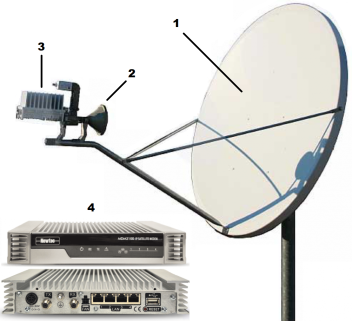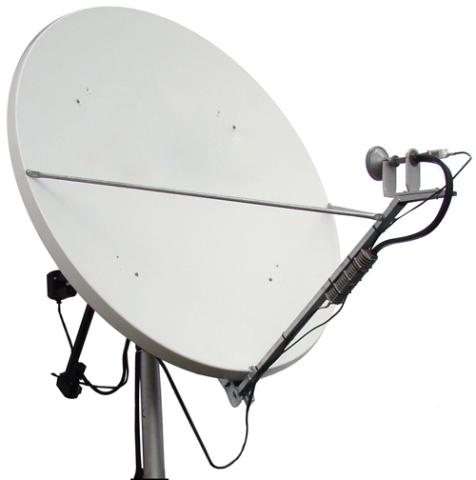VSAT satellite internet is probably one of the most established and widely used forms of satellite communication by humanitarian agencies. VSAT – short for “Very Small Aperture Terminal” – technology was developed in the 1960s, and became widely commercially available starting in the 1980s. Though prohibitively expensive in the beginning, today VSAT providers can be easily found in most countries where VSAT communications are allowed by local laws. VSATs are distinctive by their large, unidirectional satellite dishes.
VSATs work exclusively off of geostationary satellites. A variety of companies have launched multiple VSAT specific geostationary satellites in the past few decades, usually positioned above regions of the world where they believe most customers are or will be located. Though there are some universal parts to VSAT equipment, it should be noted that VSAT installations cannot switch between different satellites without obtaining new hardware, repositioning the dish, and likely entering into a commercial contract with a different service providing company. VSATs largely use the C, Ku and Ka band spectrum, and communications providers will even use specific frequencies within those bands. For this reason, specific components for VSAT provider likely cannot be used for a different provider.
VSAT connections are usually billed on a monthly basis just like a regular terrestrial based internet provider, however special arrangements can be made for usage only certain times of the day/week, or to only be used during emergency settings. The monthly cost for VSAT provided internet varies dramatically, depends on the data plan, usage, the number of VSATs governed under one contract, and the general geographic location, but can easily cost upwards of 1,000 dollars a month for a basic connection. Download speeds also vary, and depend on the hardware and the terms of the contract.
The internet service provided by VSATs, while expensive, is still largely one of the cheaper satellite internet connections available. Additionally, VSAT internet is usually capable of and suitable for supporting multiple connected computers and IP enabled devices concurrently. While upload and download speeds will never be equal to most terrestrial based connections, VSATs are still largely considered the preferred satellite option for business settings, or guesthouses where multiple persons will live and work.
Though the term “very small” would imply VSATs are little, they are actually currently one of the largest satellite communications terminals commercially used. The satellite dishes used in VSAT installations can be very heavy and measure up to 1.5 meters in length, or even more, and require a firm anchor.
Fixed VSAT Installations
In fixed installations, the dishes themselves are usually firmly attached to a standalone metal pole, which is sunk into the ground with concrete or anchored to a building. Fixed installation dishes installed at a specific location are specifically designed to match both the GHz transition frequency of the connecting satellite and the geographic location of the base station, and need to be carefully aligned and calibrated to work with the selected ISP. Installation of VSATs should only be conducted by professionals, usually working on behalf of the ISP.
Mobile VSATs
Recently, many emergency responders have moved towards more advanced mobile VSAT technology. While other mobile ground terminal technology exists, what is important about mobile VSATs is that their underlying technology is the same as regular VSATs: relatively large, specially made dishes that work off geostationary satellites. Mobile VSAT equipment must be purpose made with the mobile application in mind, including:
- Dishes that can be collapsed or taken part.
- Possibly multiple BUCs or Modems.
- Adjustable dish mount.
Some mobile VSATs are capable of automatically detecting the appropriate satellite and aligning themselves, and are referred to as “self-acquiring” VSATs. Other mobile VSATs require manual configuration every time. Mobile VSATs tend to be very expensive, and require specialised training to handle and set up. Before attempting to buy a mobile VSAT, an organisation should understand it’s intended end use. A mobile VSAT should never be used in place of a permanent VSAT wherever possible.
VSAT Components
Unlike other self-contained mobile ground terminals, VSATs are made of multiple pieces of specialised equipment that must be specified for the application.
- Satellite Dish (also called a “reflector”) – a parabolic dish of non-radio transparent material that reflects information going to and from the satellite to the focus of dish.
- Block up Converter (BUC) – BUC units convert low energy signals to high energy signals, and are used to “send” the signal from the VSAT
- Low Noise Block Converters (LNB) – LNBs convert high energy signals to low energy signals, and are used to convert data received rom the satellite into a usable signal for the modem.
- Modem – proprietary hardware that translates the signal from the satellite into usable data for a computer or computer network.

BUC, LNB and modems all require some form of external power, though usually relatively low. If a base or office will be without power for multiple times of the day or week, it will have to consider a battery back up for the VSAT if satellite provided internet is required at all times. Additionally, BUC and LNB units are outside and easily accessible. Though they are relatively low powered, users should avoid touching them or coming into contact with them while power is supplied. If necessary, the dish can be marked with a warning sign, or even be fenced off in a secure location.
Common Problems with VSATs
Though VSATs are fairly well established and well used, they are not without their problems and users can and do make common mistakes.
| Bad Weather | The bands used by VSATs – C and Ku – can be adversely impacted by bad weather, including heavy rain, thunderstorms, sandstorms and even thick fog. Any tiny particles suspended in the atmosphere can and will impact the radio signals coming to and from a satellite. |
|---|---|
| Blocked Signals | Satellite dishes used for VSATs should have a direct line of sight to sky to properly function. Buildings and structures, trees, hills, vehicles and even people can block signals if placed in front of satellite dishes. When installing a satellite dish, users should plan for activities that might occur around the dish, or future changes that might impact the installation. Trees may eventually grow to block a signal, and the tree will either need to be pruned or the dish moved. Sometimes parked vehicles or stored materials can block dishes un-intentionally. Also, do to the mostly permanent nature of the dishes, users may simply forget how they work – building a new structure or raising a compound wall may block the signal. If users are experiencing problems with VSAT signals in good weather, they should investigate if something is blocking the signal first. |
| Low Power | VSATs equipment still requires power to receive, transmit and interpret signals from space. Sometimes, under-powered equipment may still appear to be working but not actually able to perform well. Low powered or under-powered equipment may come from a poorly maintained generator or power grid. |


